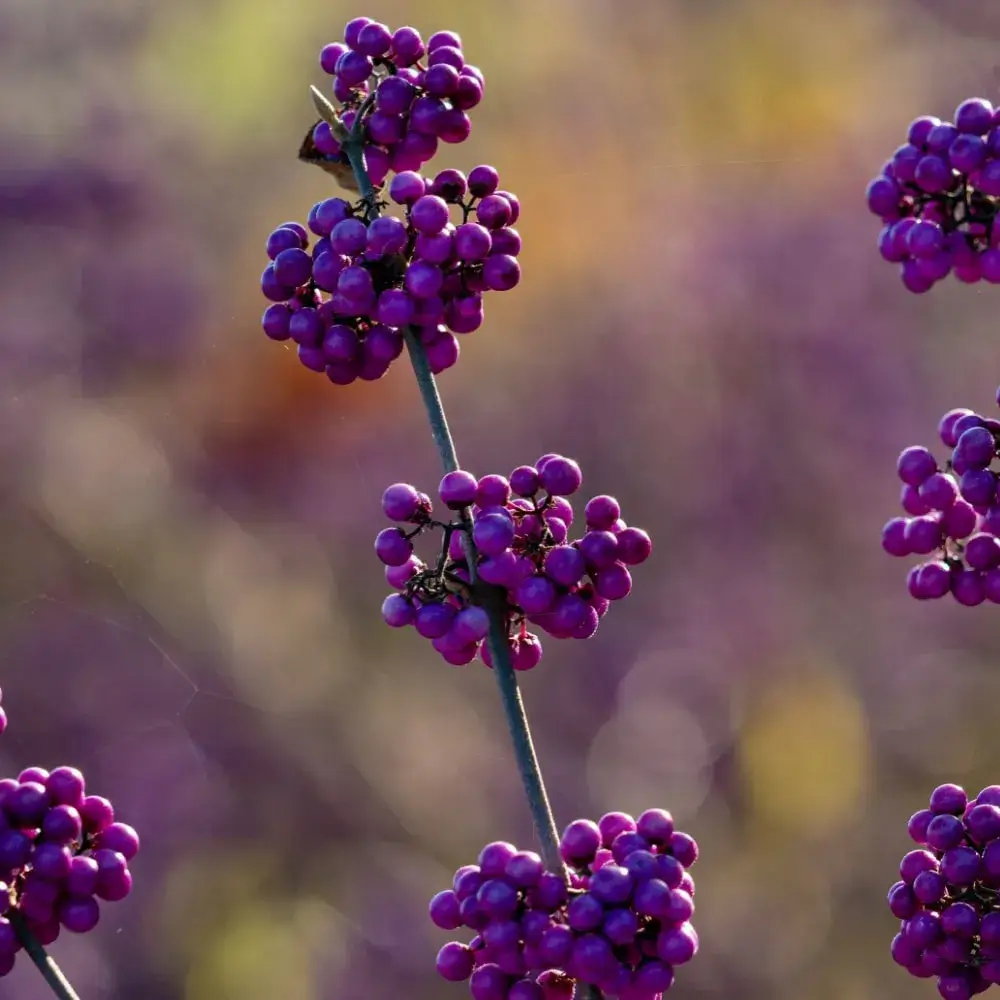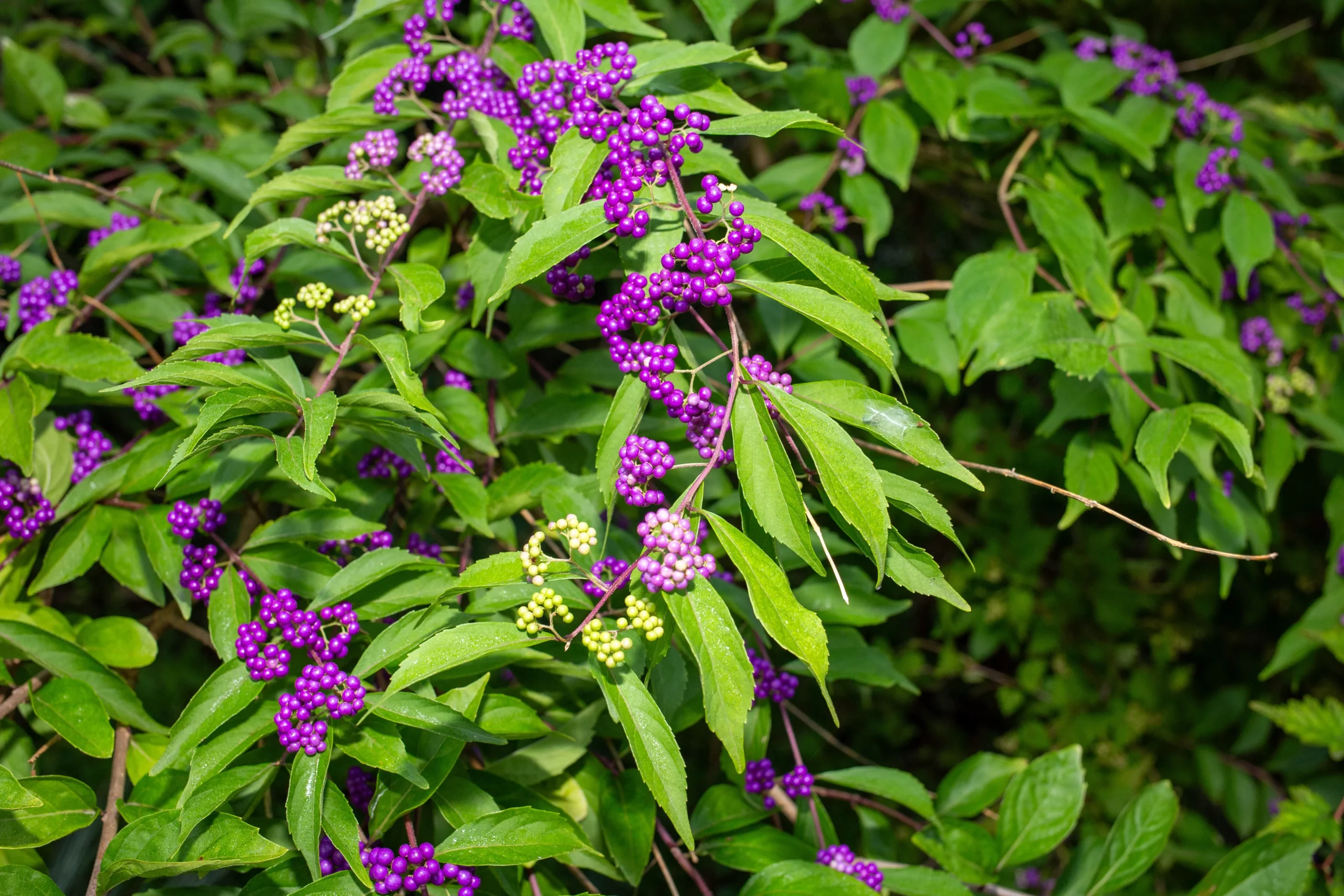Family: Beautyberry
Type: Shrub

Beautyberry, a vibrant and eye-catching plant, is renowned for its striking purple berries. These berries cluster along the plant’s arching stems, creating a stunning visual effect. Native to regions like East Asia and the Americas, Beautyberry thrives in a variety of climates. Its deciduous nature and rapid growth make it a popular choice for garden enthusiasts. In addition to its aesthetic appeal, Beautyberry offers practical benefits. It’s known for its ability to repel insects, making it a functional addition to any garden.
Hardiness Zone: 5b-7a
Pet Friendly: Yes
Moisture Preference: Average to moist
Sun Needs: Full sun to partial shade
Growth Rate: Medium
Average Height (feet): 5
Average Spread (feet): 5
Average Life Span (years): 30
Form: Arching
Flower Color: Pink
Secondary Flower Color: Cream
Flower Shape: Trumpet
Bloom Season: From early to mid summer
Foliage Color: Green
Leaf Fall Color: Yellow
Foliage Shape: Oval
Bark Color: Gray
Bark Texture: Smooth
Integrating Beautyberry into your landscaping can transform your garden’s look. Its bright berries and lush foliage provide a bold color contrast. Beautyberry works well in mixed borders or as a stand-alone specimen. Its adaptability to different soil types makes it a versatile choice. Consider planting Beautyberry near patios or windows. This positioning allows for easy enjoyment of its beauty and insect-repelling qualities.

In a cottage garden, Beautyberry adds a whimsical touch with its vivid berries and graceful form. It complements traditional cottage garden plants like roses and lavender, offering a splash of color in the late season.
Beautyberry suits woodland gardens, blending seamlessly with shade-loving plants. Its naturalistic look enhances the serene, forest-like ambiance of such a garden style.
In a modern minimalist garden, Beautyberry stands out as a focal point. Its simple yet striking appearance complements the clean lines and open spaces typical of this style.
Use Beautyberry to create a natural border or hedge. Its dense growth provides privacy while adding beauty to your space. Combine Beautyberry with ornamental grasses for a dynamic texture contrast. This combination works well in contemporary garden designs. Plant Beautyberry along walkways or garden paths. Its cascading berries create an enchanting, inviting pathway.
Select our pre-made garden layouts to create a landscape that’s uniquely yours. Simple, smart, and customizable!
In spring, Beautyberry bursts into new growth, with fresh green leaves emerging. The plant's foliage starts to form the backdrop for its later berry display.
During summer, the Beautyberry's leaves fully develop, creating a lush green backdrop in your garden. This is the period before the berries appear, setting the stage for the vibrant show to come.
Fall is when Beautyberry truly shines. The plant's iconic purple berries ripen and become prominent, offering a striking contrast against the fading colors of other plants.
In winter, even after leaf drop, Beautyberry's berries often persist, providing visual interest and a pop of color in an otherwise barren landscape. This resilience makes it a valuable plant for year-round appeal.
Beautyberry flourishes in areas that receive full to partial sunlight. It’s ideal for planting in open spaces in your garden or against a backdrop of taller shrubs and trees, where it can receive ample light while enjoying some shade.
This plant thrives best in full sunlight but can also tolerate partial shade. The amount of sunlight Beautyberry receives can influence the vibrancy of its berry production, with more sun leading to more prolific berry clusters.
Beautyberry is not fussy about soil types and can grow in a range of conditions. However, it prefers well-draining soil with a slightly acidic to neutral pH. Ensuring good soil drainage is key to prevent root rot.
When planting multiple Beautyberry shrubs, space them about 3 to 5 feet apart. This spacing allows each plant enough room to spread and ensures adequate air circulation, reducing the risk of disease.
The best time to plant Beautyberry is in the early spring or fall. Planting during these cooler seasons allows the roots to establish themselves before the stress of extreme summer heat or winter cold.
Dig a hole twice as wide and the same depth as the root ball. Place the plant in the hole, backfill with soil, and water thoroughly. This ensures the roots have good contact with the soil and reduces transplant shock.
Regular watering is crucial in the first season after planting to establish a strong root system. Once established, Beautyberry is drought-tolerant, requiring less frequent watering.
Feed Beautyberry with a balanced, slow-release fertilizer in early spring. This supports healthy growth and berry production but avoid over-fertilizing, which can lead to fewer berries.
Prune in late winter or early spring. Beautyberry blooms on new wood, so pruning stimulates growth and berry production. Remove any dead or diseased wood and thin out for better air circulation.
In spring, remove any winter damage and apply mulch to conserve moisture. This is also the time to apply fertilizer to support new growth.
During summer, Beautyberry requires minimal care. Monitor for pests and diseases, and water during prolonged dry periods.
In fall, Beautyberry's berries are in full display. Reduce watering as the plant prepares for dormancy, and clean up any fallen leaves to prevent fungal issues.
In winter, Beautyberry is dormant. No active care is needed, but ensure the plant is well-mulched to protect its roots from freezing temperatures.
Beautyberry is a fast-growing plant, often adding several feet in a single season. This rapid growth makes it an excellent choice for gardeners looking to quickly establish a presence in their landscape.
While not the tastiest, Beautyberry berries are edible and have been used in traditional recipes like jellies and jams. However, they are more valued for their ornamental appeal than for culinary use.
Yes, Beautyberry is quite hardy and can survive winter, especially in USDA zones 6 through 10. In colder regions, the plant may die back to the ground but typically resprouts in spring.
Sign up below to get exclusive deals, discounts, and new plant collections—delivered straight to your inbox! Plus, stay inspired with the latest gardening tips, landscaping trends, and DIY garden ideas. Start growing with us today!
A big thank you for subscribing to the PBN Design newsletter.
We're thrilled to have you join our community. Get ready for exciting updates, insightful content, and more delivered straight to your inbox.
Stay tuned!
Go backA big thank you for subscribing to the PBN Design newsletter.
We're thrilled to have you join our community. Get ready for exciting updates, insightful content, and more delivered straight to your inbox.
Stay tuned!
Go back